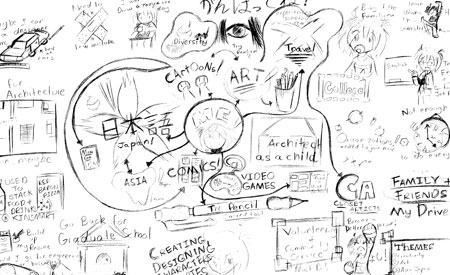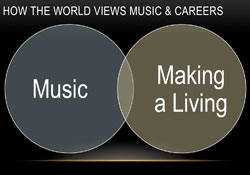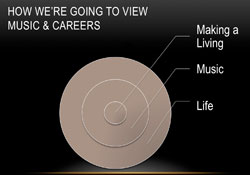Visual maps provide career direction
While post-graduation plans may be crystal clear for accounting majors, students with liberal arts degrees may find career options to be endless, and at times, overwhelming.
Now the Office of Personal and Career Development (OPCD) is helping students better navigate their career paths with wandering maps — or ‘vision boards’ — that creatively capture the patterns and themes in life’s most significant moments, actions, interests and feelings.
The wandering map can take shape in the form of a simple pencil sketch or a colorful creation with magazine clippings and bright drawings. At Wake Forest, students are making these in their college-to-career classes or in Studio 230 — a dedicated space in the OPCD filled with glossy periodicals and art supplies.

“As far as we know, we are the first university to set up a designated area in a career center with the tools and support for students to use visual thinking techniques to create a personal map and assess their career plans,” says Katharine Brooks, executive director of personal and career development at Wake Forest and author of “You Majored in What? Mapping Your Path from Chaos to Career.”
To create a wandering map, start by putting yourself in the center of the page. Then, working quickly, add short phrases, pictures and/or drawings of the things that have been most important in your life. Next, make connections that when you first look, seem to be dissimilar but are, in fact, linked in surprising ways.
Making connections
“One student of mine drew a line connecting her favorite TV show, ‘Law & Order: SVU’ to her love of playing poker, to having a sister with cerebral palsy,” says Brooks. “When I asked her what the connection was, she said all of those things honed her ability to problem solve and strategize. She liked to guess who the villain was in ‘SVU.’ She used strategic thinking in her tournament-winning poker playing. And because her sister had physical and learning challenges, she was always trying to come up with strategies for helping her gain access to inaccessible places and do better in school by finding other ways to help her learn.” When designing a career path, Brooks says look at your whole life. What do you love? What were your struggles, and what were the turning points?
“Let’s say you’re a music major. ‘Big picture’ visual mapping moves the focus away from asking, ‘How am I going to make money?’ Instead it’s a wide-angle view on choosing ways to make a living that fit within your life rather than just intersecting it in a small way,” Brooks says.
Applying the lessons
For senior Toia Gathings, creating a wandering map in her college-to-career class this semester helped her think differently about her post-graduation options.
“The map highlighted three key qualities about myself that I had never noticed before: self-determination, a joy in helping others and being results-oriented. The discovery swayed my career decisions a bit. Before the class, I was set on law school. After, I realized my personality may also be valuable in areas such as marketing and public relations. Inspired by the map, I applied to three marketing companies and have received a job offer,” Gathings says.
“Creating a wandering map isn’t just a feel-good exercise,” says Brooks. “Students explore difficult challenges that have tested their mettle. But by identifying the skills in which they are particularly strong, they can think about how the would apply them in the workplace. One student, having dealt her whole life with cultural issues and challenges in her family, discovered her thread of reconciliation and openness to differences and became a professional mediator.”
When it comes to the job interview, an interviewee who uses narrative to explain why they are a good fit for a position is more likely to make an impression, says Brooks. “For example, a student might say, ‘My father taught me to play chess when I was young, and I play regularly in tournaments. My ability to predict the next move and plan ahead will be assets in the investment banking field.’”
With vision maps, students can see how their talents and passions connect to the work they will do after graduation.
Categories: Campus Life, Experiential Learning, Personal & Career Development, Research & Discovery, University Announcements
Media Contact
Wake Forest News
media@wfu.edu
336.758.5237






